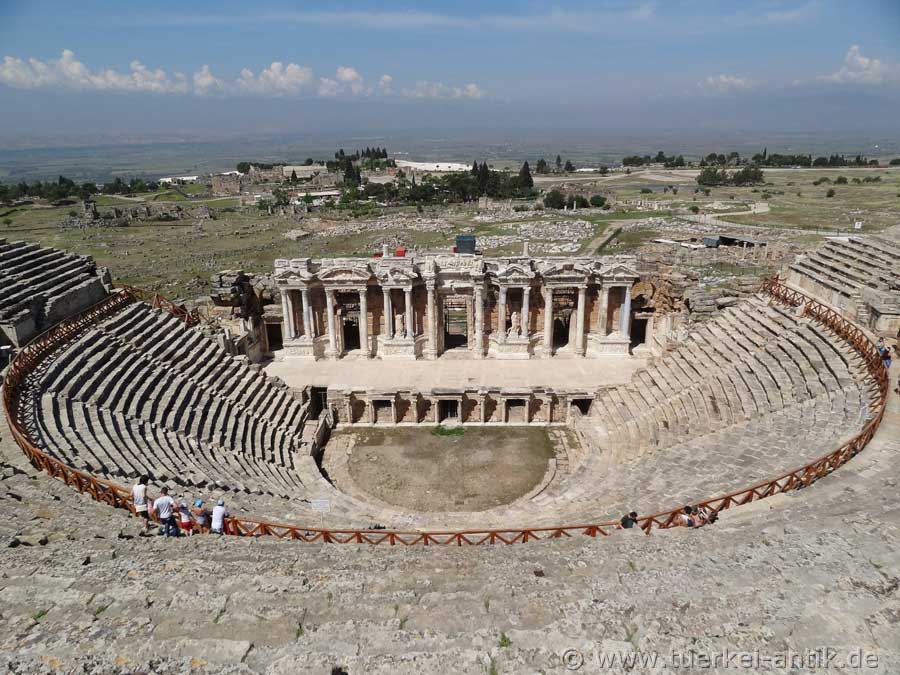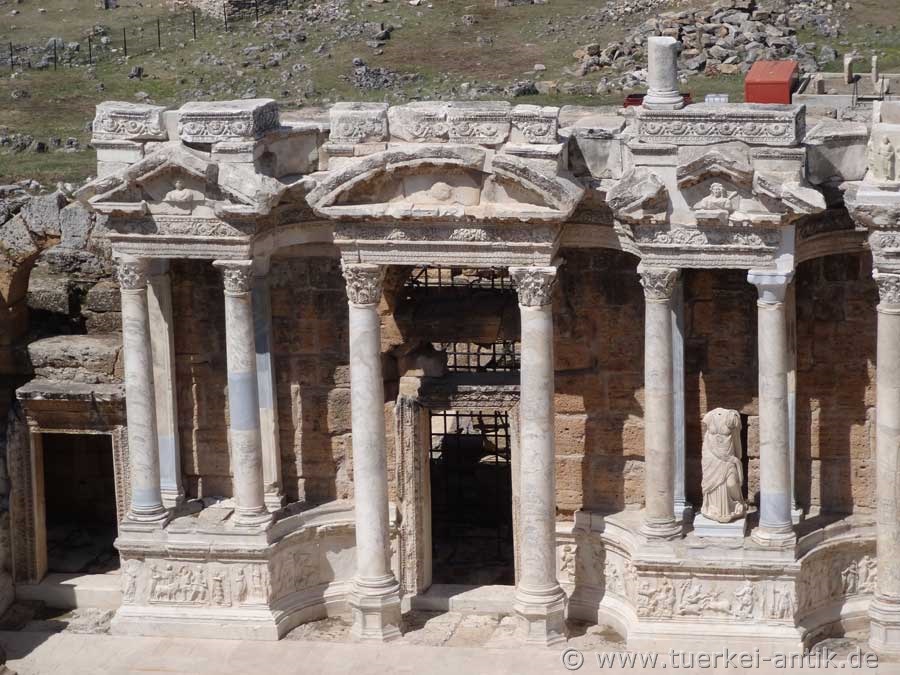 |
| Hierapolis in Phrygia | |||
|
|
|
||
| The Greek-Roman North Gate, the Frontinus Gate | |||
|
Hierapolis was an ancient Greek city on the road from Sardeis to Apameia. The place was already famous in antiquity for its warm springs, whose water produces white lime sinter terraces by evaporation. The water was used to dye wool. Weaving and textile trade formed the basis of the city's wealth. |
|||
|
|
|||
| Large latrine just behind the Frontinus Gate | |||
|
Even the Romans came to Hierapolis to relax in the thermal springs, to recover or to cure various ailments. The thermal baths and the temple district were the centre of this spa town, which flourished in Roman imperial times. A huge bath complex still bears witness to the popularity of the 30-50 °C hot baths. |
|||
|
|
|||
| The Byzantine North Gate | |||
|
Even if the city, as an allegedly old Kybelekult shows, probably already existed earlier, the oldest testimonies come from the 3rd century BC Hierapolis was founded, just like the neighbouring city Laodikeia at Lykos, by Antiochos II (286 to 246 BC). The older settlement traces are covered by travertine layers. The city was destroyed by earthquakes in 17 A.D., but was then rebuilt in its extended form. In the first and second centuries thermal baths, fountains, theatres and temples were built. The numerous sarcophagi and graves in the city's necropolises also date from this period. |
|||
|
|
|||
| Beginning of the North Necropolis | |||
|
More than 1200 graves lie in front of the northern gate of Hierapolis. They belong to the largest ancient necropolis in Asia Minor. House-shaped sarcophagi can be found there, temple-shaped houses of the dead and tumulus tombs, often with a burial chamber and benches inside.
|
|||
|
|
|||
 |
|||
| The Roman Theatre | |||
|
|
|||
|
The well-preserved theatre from the 2nd century A.D. dominates the excavation area. It was built under Emperor Hadrian, who visited the city in 130 AD. The stage house was lovingly reconstructed by the Italian excavators. One can still imagine today how splendid it once presented itself. It held 10,000 spectators. Today the theatre can only be entered from above via the spectator terraces. |
|||
|
|
|||
|
|
|||
|
Decoration of the stage house |
|||
|
|
|||
|
|
|||
| The Temple of Apollon | |||
|
The remains of the temple of Apollo no longer indicate its former splendour. Only a pedestal and stairs are preserved.
Also in the immediate vicinity of the ruins of the temple of Apollo are the remains of a monumental nymphaeum, a fountain from Roman times. 600 metres above the theatre is the martyrdom of Saint Phillip, a square tomb with an edge length of 60 metres. Since a grave was never found, it is not certain that the saint was really buried here. The building was erected at the beginning of the 5th century A.D. and destroyed 100 years later by an earthquake. From the "Antique Pool", the former column road donated by Emperor Domitian leads north. Via Frontinus, the street paved in parts with marble slabs, was the main street of Hierapolis and led from the southern gate through the whole city to the Frontinus gate with its two round towers. In Byzantine times, the city centre was surrounded by a wall. On the height of the former large agora a defensive gate was erected above the column road.
|
|||
| Photos: @chim | |||
| Translation aid: www.DeepL.com/Translator | |||
| Source: Wikipedia and others | |||
|
|
|||


